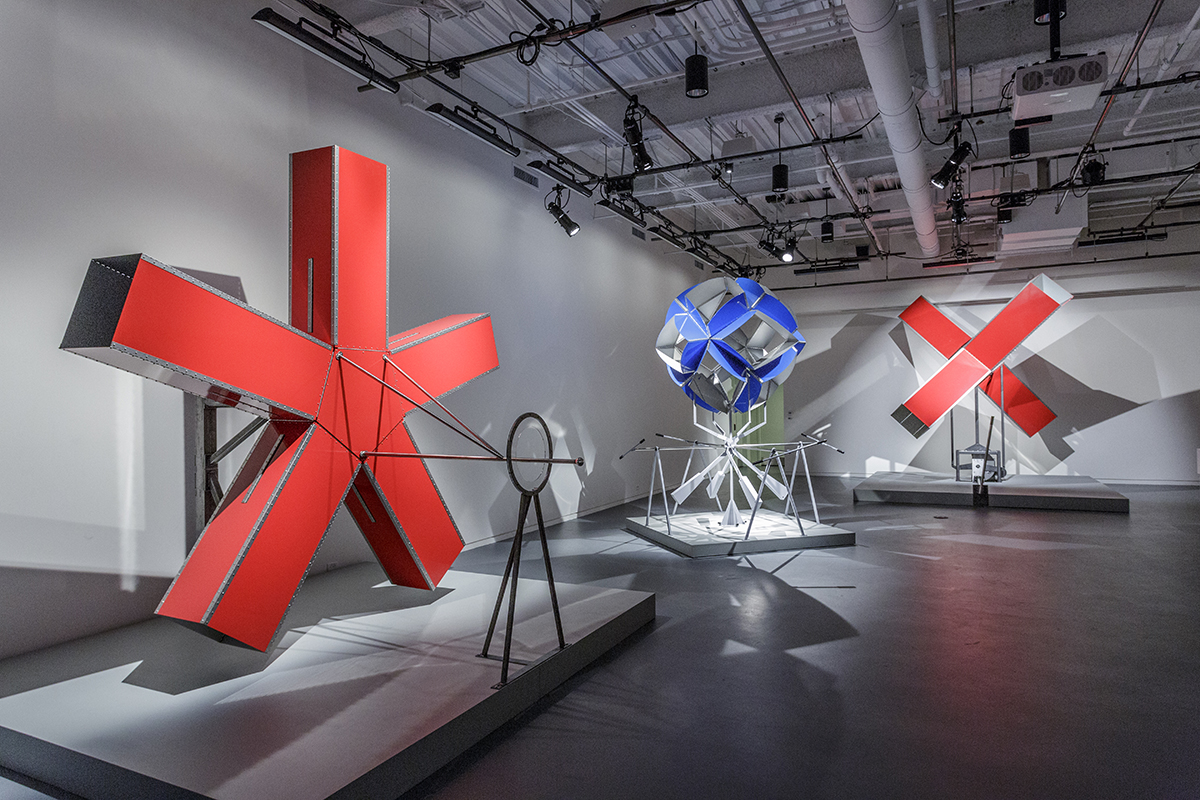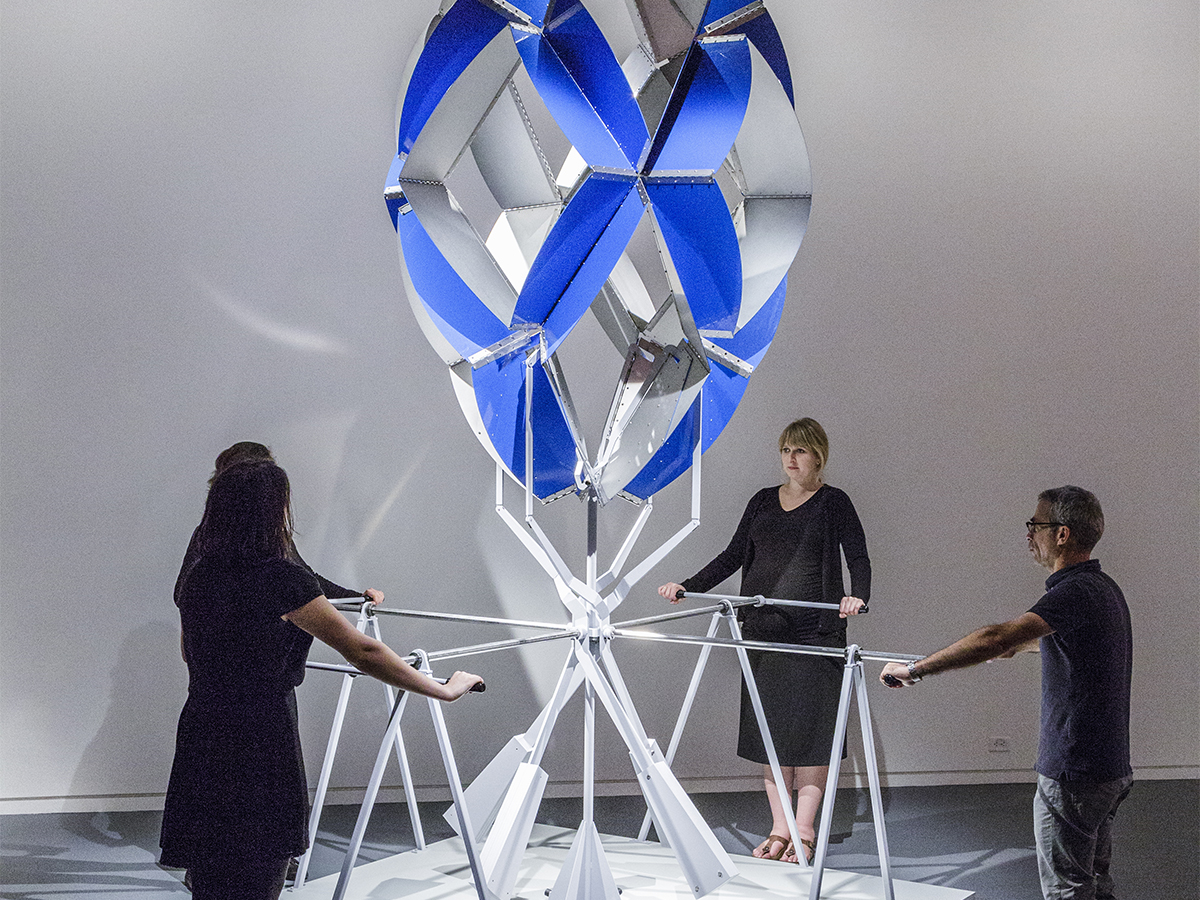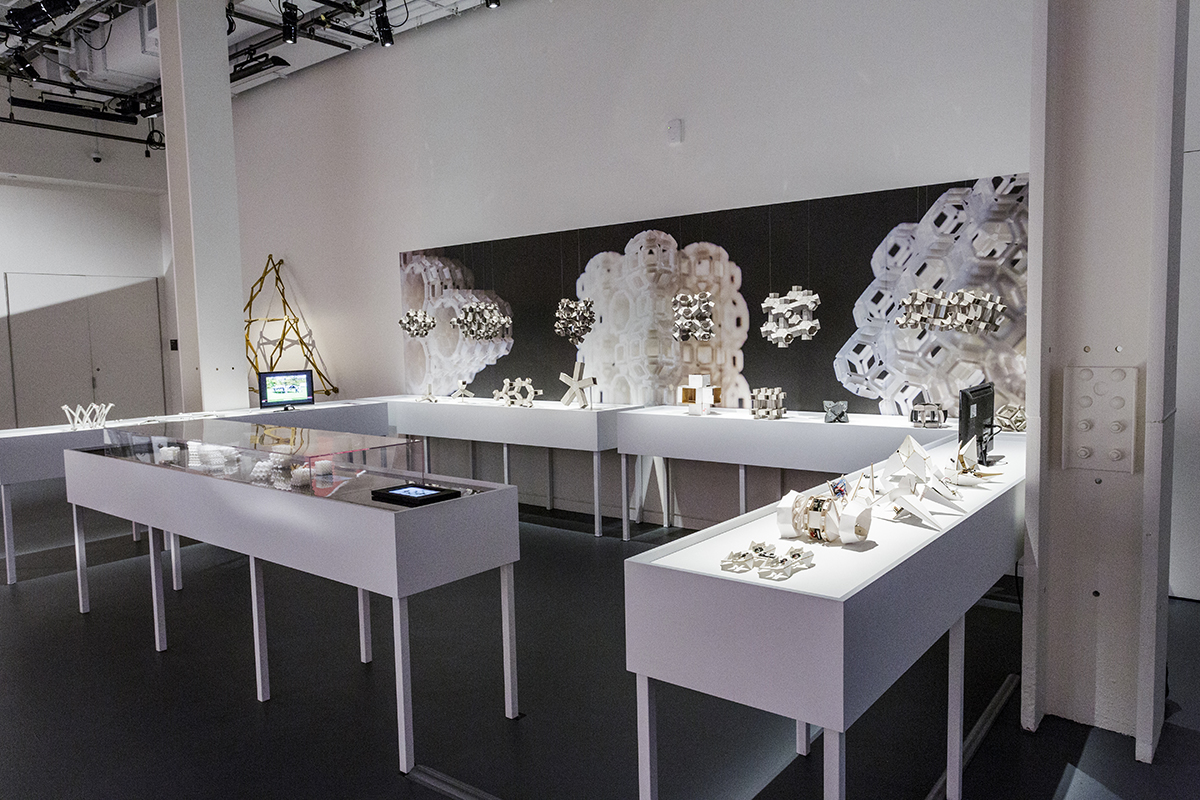See Transformable Structures at Le Laboratoire Cambridge

Photo via Le Laboratoire Cambridge
If you played with toys in the early ’90s, you’ll probably remember those brightly colored retractable plastic contraptions that expanded like fireworks. For those unaware, the iconic toy is called Hoberman Sphere, named after Chuck Hoberman, an engineer-professor-artist-toymaker whose exhibition 10 Degrees opened at Le Laboratoire Cambridge last month.
The interactive exhibition features four larger-than-life structures numerically titled “One” through “Four.”
“Not the most catchy names,” says Hoberman. “But that’s where the title of the exhibition comes from. Ten degrees is the total—ten degrees of freedom, you have ten things that you can control.”
Each piece has a lever that viewers can move, spurring the massive, hundred-pound shapes into motion; the number of levers indicate the number of changes in the sculpture’s movements. The slightest exertion can cause the shapes to seamlessly fold into arrangements with a delicacy unexpected for a metal structure of such magnitude.
“There’s the idea that you’re able to fluidly transform an object that is bigger, larger than yourself,” says Hoberman. “These are obviously geometric, but once we all start moving it, you get this other sense that there’s something also organic about it—and that’s really the motion. It’s a little bit like music.”
Transformation and motion are far from novel concepts in Hoberman’s career. “Everything that I work with is about creating physical objects that can change and transform in size, shape, form, and sometimes surface property,” says Hoberman.
Over the last two decades, Hoberman’s exploration of transformable structures have earned him international recognition; some works include the Hoberman Arch in Salt Lake City for the 2002 Winter Olympics, and an expanding video screen for the U2 360° world tour.
“The motivation is really to take something that would normally be considered a cold and dry mechanism and turn it into something that’s much more living and organic,” explains Hoberman. “In the natural world, everything is constantly transforming.”
Le Laboratoire founder David Edwards had approached Hoberman with only one requirement for the exhibition: something that’s never been done before.
“My toys, of course, are hands-on, but most of the big, sculptural work that I make is motorized,” Hoberman says. “They’re spectacles and they’re pretty impactful, but there’s distance.” And so Hoberman closed the gap with interactivity: “One thing I wanted to do was to really explore interaction in a new way.”

Photo via Le Laboratoire Cambridge
Something else that influenced Hoberman’s creations is a simpler form of folding also reminiscent of childhood: origami. He says, “It’s something that goes back to my roots before I designed Hoberman Sphere, where I was working a lot with pop-up origami.” The structures in 10 Degrees certainly move with the ease of folded paper. “As a kid there’s something amazing about a sheet of paper that you can turn into a bird—it’s really magical,” he says.
“Number Two,” or what Hoberman’s friend aptly calls “The Asterisk,” incorporates movement akin to a pendulum, which Hoberman compares to pushing a child on a swing. Play is a subtle undercurrent of the entire exhibition. “I’m also a toymaker,” says Hoberman. “That wasn’t intentional on my part, but the Hoberman Sphere really changed me a lot because it was to me an amazing structural essay about all kinds of principles, but to a kid it was just like, wow!”
A similar sentiment applies to 10 Degrees, which can be approached in any way—mathematically, scientifically, aesthetically, playfully— and to any degree that one chooses.
“Some people will hopefully have a good time playing with them and that’s it. And that’s fine,” says Hoberman.
He draws the comparison between the mind-body connection, in which there doesn’t need to be conscious acknowledgement or articulation of the underlying ideas—the relationship between geometric transformations and natural motions—in order for it to exist. Hoberman notes, “I think we make a mistake if we assume that we [can only] understand things because we write words. At the end all our ideas have to be grounded in our senses.”

Photo via Le Laboratoire Cambridge
Adjacent to the sculptures are displays of works by Hoberman’s students from his class at Harvard’s Graduate School of Design. There are also earlier renditions of the structures made from cardboard—among them is a model of “Three,” constructed by a discarded cardboard Saks Fifth Avenue box.
“I woke up in the middle of the night having this thought of a cube with extruded faces and got up the next day, had my coffee, got a cardboard box and made it,” Hoberman says. “This funny idea that came out of this box has an enormous amount of possibilities.”
10 Degrees will be on view through January 7, 2017 at Le Laboratoire Cambridge, 650 East Kendall St., Cambridge. The exhibit is free. Gallery hours are Wednesday through Friday, 12 p.m. to 9 p.m., and Saturday, 11 a.m. to 10 p.m, lelaboratoirecambridge.com.


